Your Planets
Portraits of the Planets
Aspects between Planets
The planetary ages
The planetary families
Planets in Signs
The Planets in comics


The Signs of the Zodiac are nothing other than the division of the ecliptic plane into twelve equal sectors of 30°. Each of them is characterized by a specific declination, increasing or decreasing. The declination zodiac is universal: wherever you are on Earth, the planetary declinations—and their effects on human beings—are identical.
From a heliocentric point of view, the Earth revolves around the Sun, thus determining its orbital plane. It takes 1 year to complete a full turn. At the same time, it turns on itself (around its axis of rotation inclined at 23.45° with respect to the plane of its orbit) in 24 hours, with a movement similar to that of a top.

We also know that the planets of the solar system do not describe their orbit exactly in the same plane as that of the solar equator. This is why we have defined a zodiacal band which extends on either side of the ecliptic (so called because it is when two stars are exactly there that eclipses occur) and inside which the planets are located, at the exception of Pluto, whose particular case will be examined later. From a geocentric point of view, this zodiacal band can be represented as in the figure below.
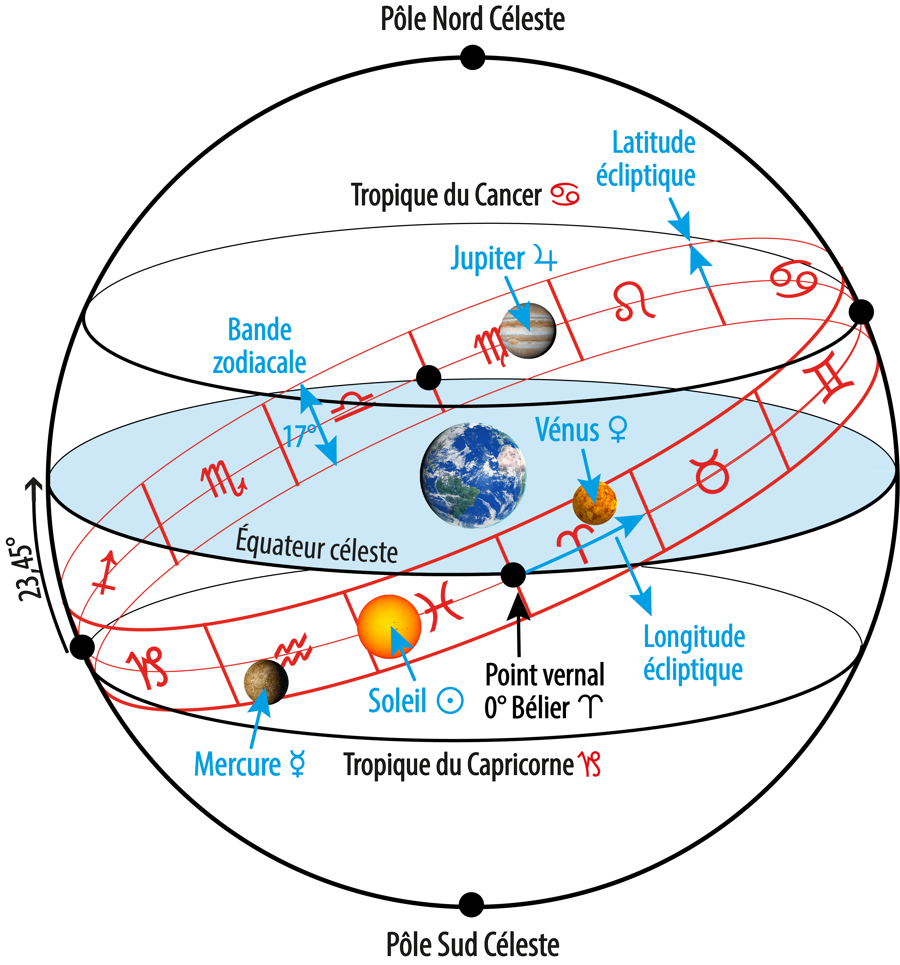
It is the phenomenon of the tilting of the Earth in its orbit which is at the origin of the seasons—the manifestations of which are subject to multiple variables—and above all, the most sensitive phenomenon, of the durations of sunshine, which vary according to the seasons and the terrestrial latitudes.
From a geocentric point of view, it is the Sun that seems to revolve around the Earth in 1 year. Its apparent orbital plane is therefore inclined — inversely to reference — by 23.45° with respect to the plane of the celestial equator. This apparent orbital plane is called the ecliptic. The height of the Sun on the ecliptic with respect to the celestial equator is called declination. Depending on whether a star is in the Northern or Southern hemisphere, it will therefore have a North or South, increasing or decreasing declination. It is the phenomenon of declinations that astronomically establishes the zodiac (see the zodiac of declinations below).
The plane of the ecliptic intersects the plane of the celestial equator at two points, at 0° Aries (also called vernal point) and at 0° Libra. These two points determine the axis of the equinoxes. Indeed, when the Sun passes the equator, there is equality of days and nights whatever the terrestrial latitude.
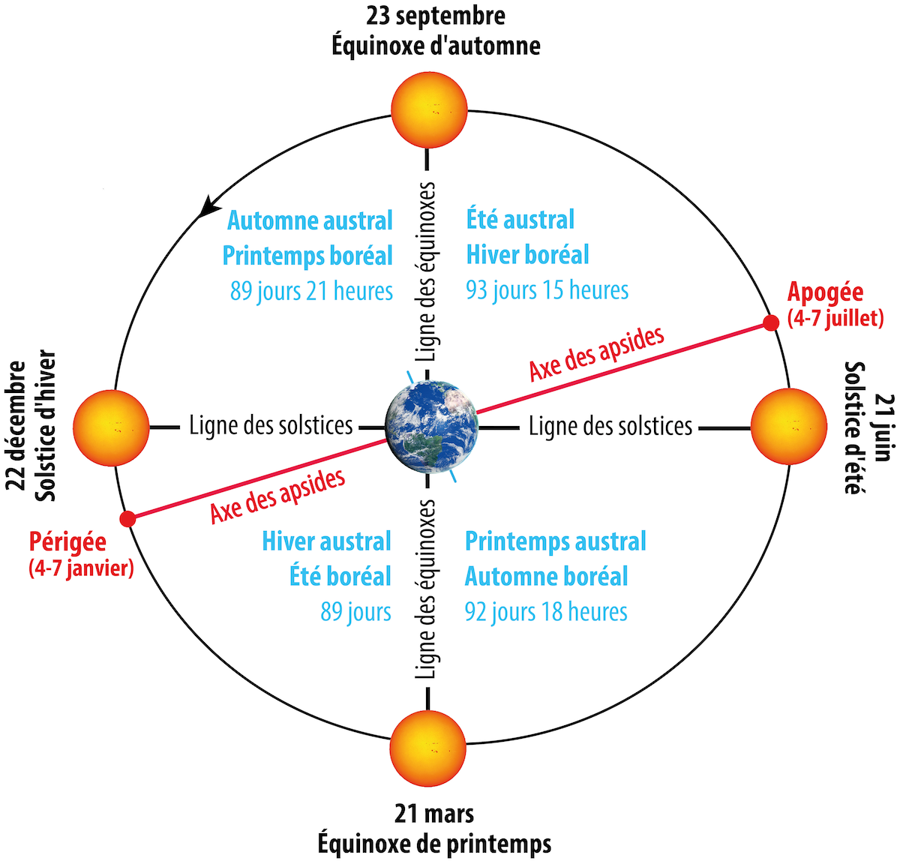
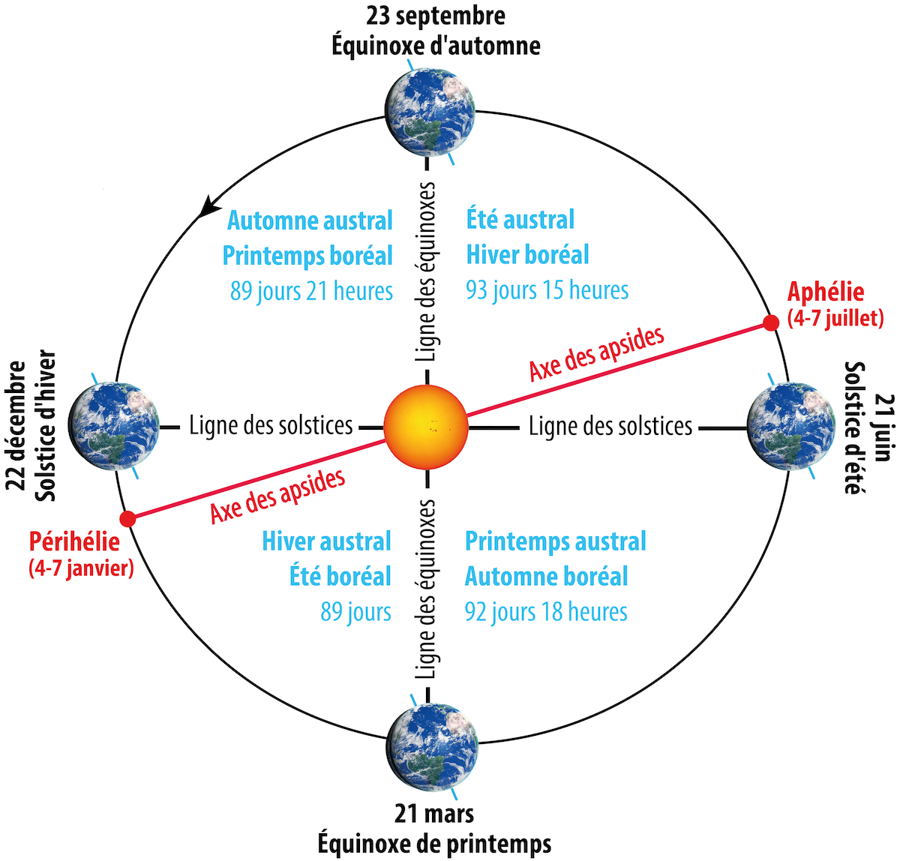
The ecliptic reaches its greatest North and South declinations at 0° Cancer (+23.45° North) and 0° Capricorn (−23.45° South). These two points determine the axis of the solstices. When the Sun is at the height of the tropics, the duration of the days and nights reaches its maximum of inequality, this maximum varying according to the latitudes (maximum inequality at the northern and southern circumpolar latitudes, average at the latitudes of the tropics of Cancer and Capricorn, minimum or zero at equatorial latitudes (right at the equator, daytime durations are always equal to nighttime durations).
The Signs of the Zodiac are nothing other than the division of the ecliptic plane into twelve equal sectors of 30°. Each of them is characterized by a specific variation, increasing or decreasing (see table opposite). The declination zodiac is universal: wherever you are on Earth, the planetary declinations — and their effects on human beings — are identical.
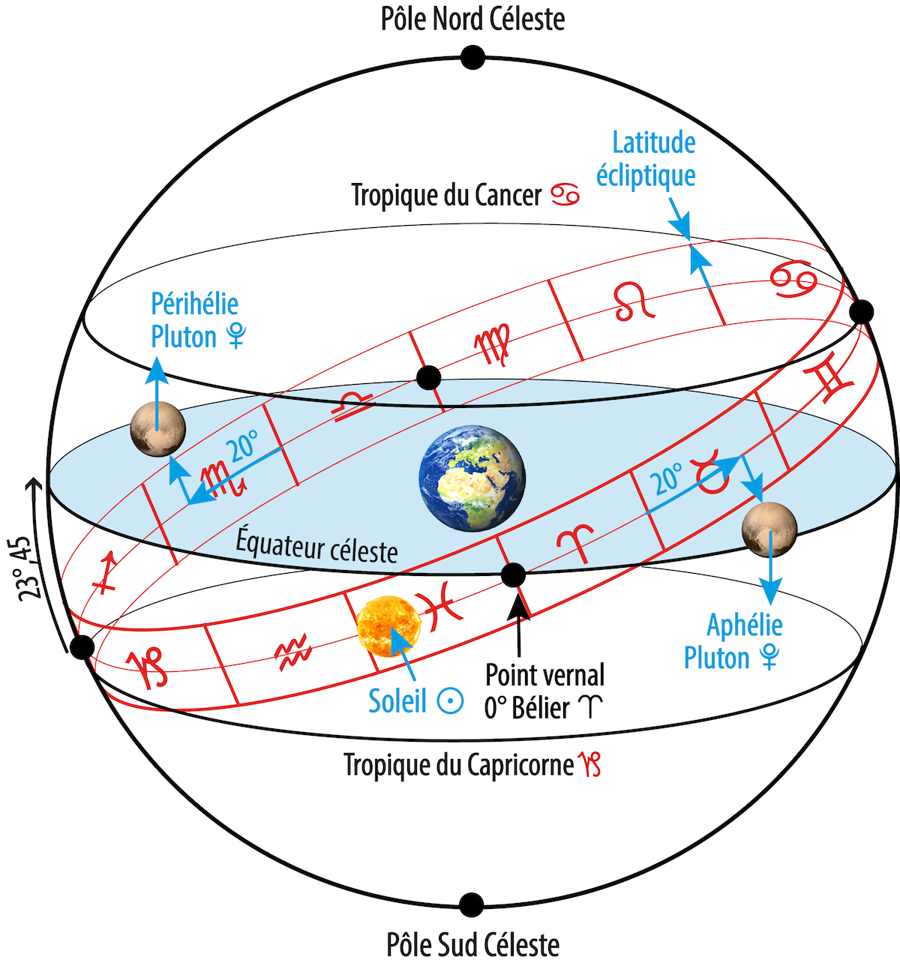
No planet faithfully follows the course of the Sun on the ecliptic: their orbits are all more or less inclined with respect to this plane (left table above), and their ecliptic latitudes (heights north or south in relation to this plane) vary according to the periodic oscillation of their orbit, which affects their declinations: each planet thus has its own zodiac, different from the solar zodiac.

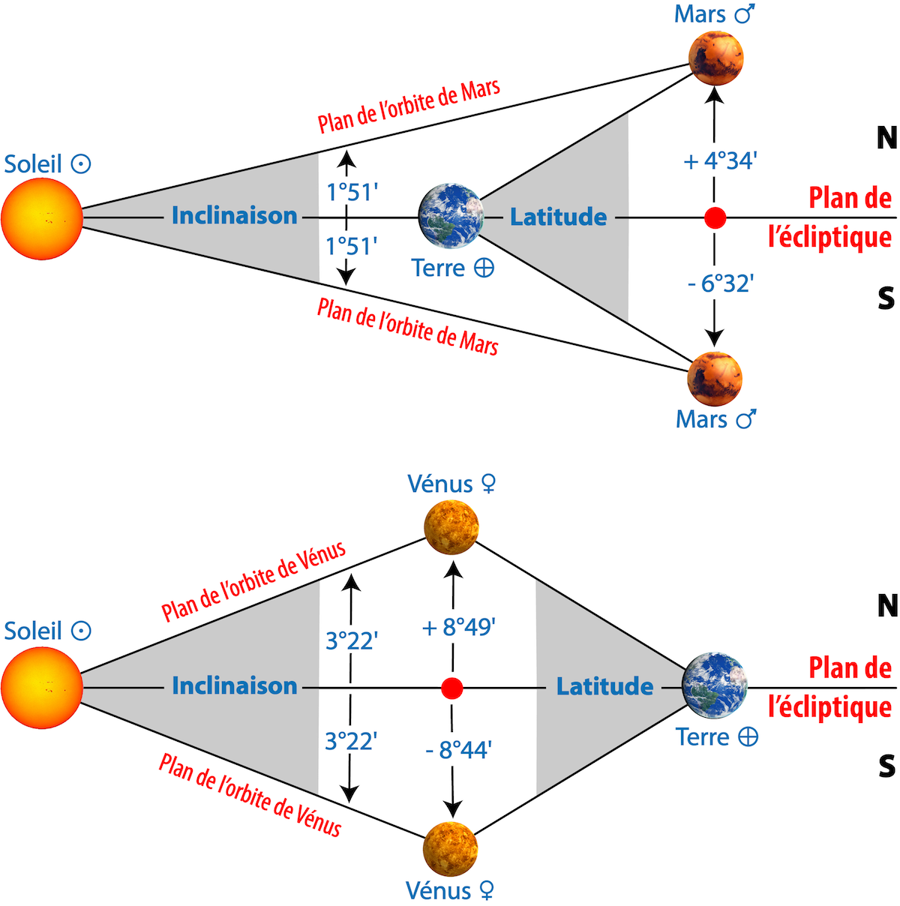
It is the orbit of Pluto which has the strongest inclination (approximately plus or minus 17°) on the ecliptic. When he is at his ecliptic latitudes Maximum North or South, it is located outside the zodiacal band of 8.5° which contains approximately the apparent trajectories of all the planets which were known in antiquity.
The plane of Pluto’s orbit intersects that of the ecliptic in the axis of approximately 20° Cancer-Capricorn longitude. It is at its perihelion (minimum distance from the Sun) at around 20° Scorpio and at its aphelion at around 10° Taurus (maximum distance from the Sun). Pluto’s orbit is at its maximum North declination when it is in Leo longitude and South in Aquarius longitude. However, the ephemeris, which astrologers use to calculate the charts, only consider the projection of the positions of Pluto on the plane of the ecliptic, without taking into account its real declinations. Therefore the positions of Pluto in Signs given by the ephemerides are false.
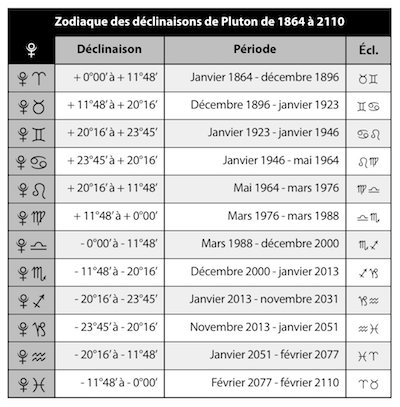
The table above shows the actual positions of Pluto in Signs for its entire current cycle, from 1864 to 2110. It can be seen that Pluto takes much longer to travel through its Taurus positions (27 years) than its Scorpio positions (13 years). This is explained by the fact that Pluto is at its aphelion (point of its trajectory farthest from the Sun) in Taurus: it is therefore much slower than when it is at its perihelion (point of its trajectory closest to the Sun) in Scorpio.
The complete cycle of Pluto’s declinations spreads out between −6° and +6° in amplitude during the centuries when its orbit is at most parallel with our celestial equator, while this same cycle spreads out between −40° and +40° of amplitude during the centuries when its orbit is most inclined with respect to the equator.
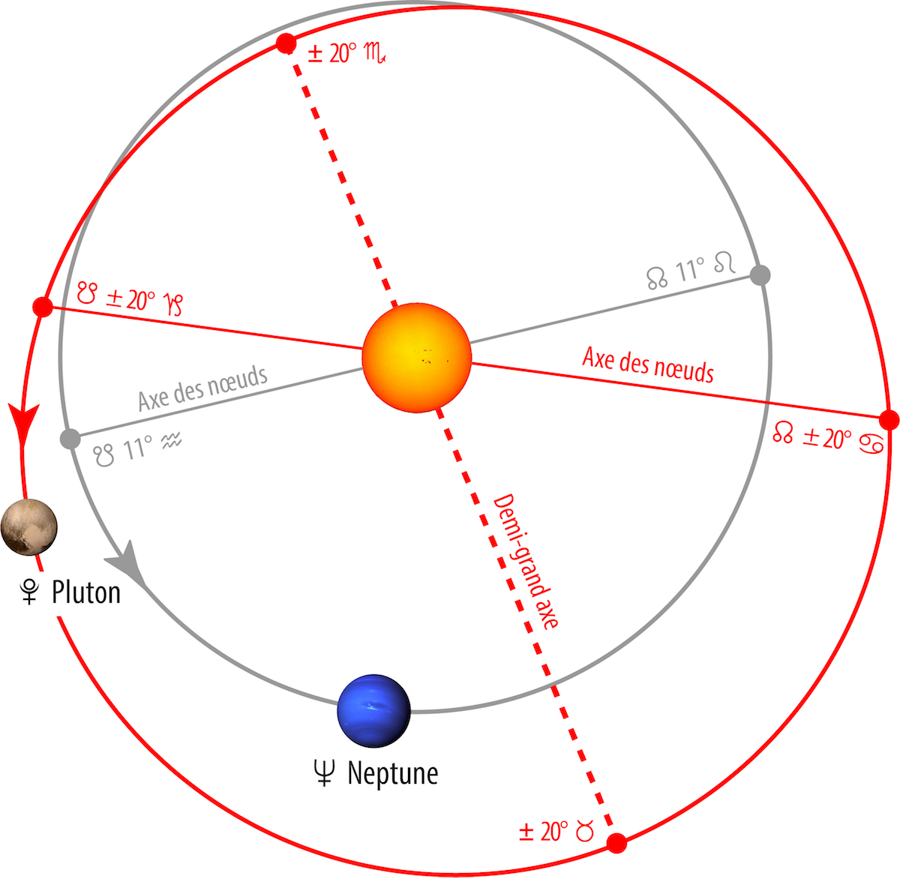
The table below represents the sinusoids of the declinations of the Sun (ecliptic, in orange) and Pluto (in black). The Zodiac Signs below are defined by the positions of the Sun on the ecliptic. The black circles on the sinusoid of Pluto represent the real positions in Signs of this planet.
▶ Example: the Sun’s declination of 0° on the equator (beginning of the orange sinusoid of the ecliptic on the left) corresponds to 0° Aries. The dashed lines parallel to the equator correspond to the declinations which define the limits between the Sun Signs. If we project the position of Pluto on the ecliptic as the astrological ephemerides do, it is effectively at 0° Aries. But in reality its declination is −14° 56′ South, which corresponds to a position of the Sun in Aquarius. While the declinations of the Sun in Aries on the ecliptic will increase in the northern hemisphere up to 11,48° (beginning of Taurus), those of Pluto will increase in the southern hemisphere, going from Aquarius-like declinations to Pisces type. This means that a Pluto located at the beginning of Aries in the ephemerides is actually to be interpreted as a Pluto in Aquarius, and as a Pluto in Pisces if it is in the second half of Aries…


When the Sun is in the northern hemisphere, the days are longer than the nights for the inhabitants of this hemisphere. When it crosses the southern celestial hemisphere, it is the reverse. When the declination of the Sun is increasing in the northern hemisphere, the length of the days increases (Spring), and decreases at the same time as the declination (Summer), and it is the opposite when the Sun is in the southern hemisphere: the nights, dominant in duration, increase (Autumn) as the southern declinations of the Sun become greater, and decrease (Winter) as the declinations decrease. It is obviously the opposite for the inhabitants of the southern hemisphere: the boreal spring corresponds to the austral autumn.
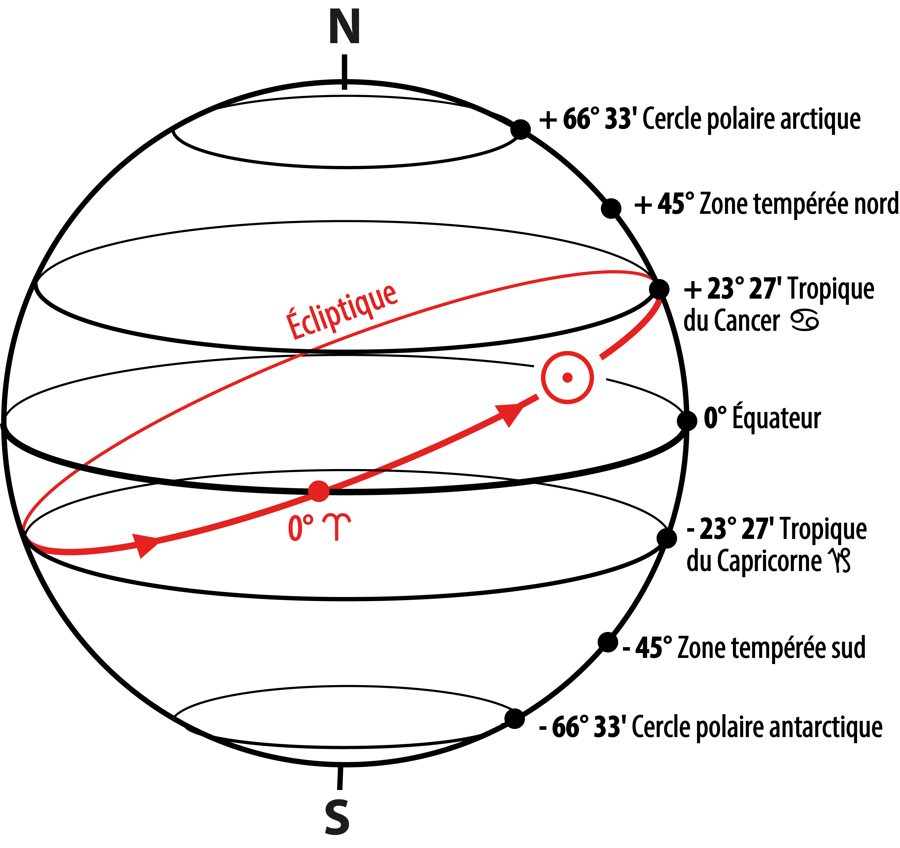
The Earth is divided into climatic zones. In a completely independent way of the climate (weather), the inclination of the ecliptic and the diurnal-night durations vary according to these zones. The following diagrams representing the movement of the planets in the local sphere during the solstices and equinoxes in the 5 climatic zones: equator (0°), tropic (23°), temperate (45°), glacial (75°), polar (90°).
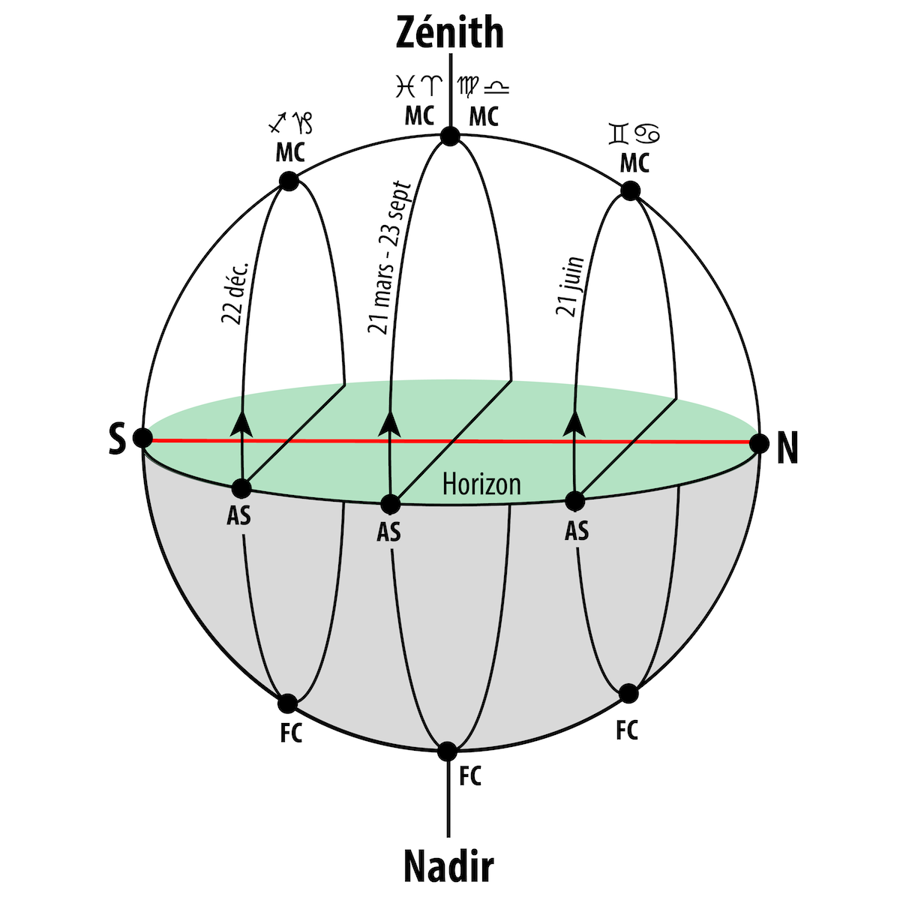 Equatorial zone
Equatorial zone
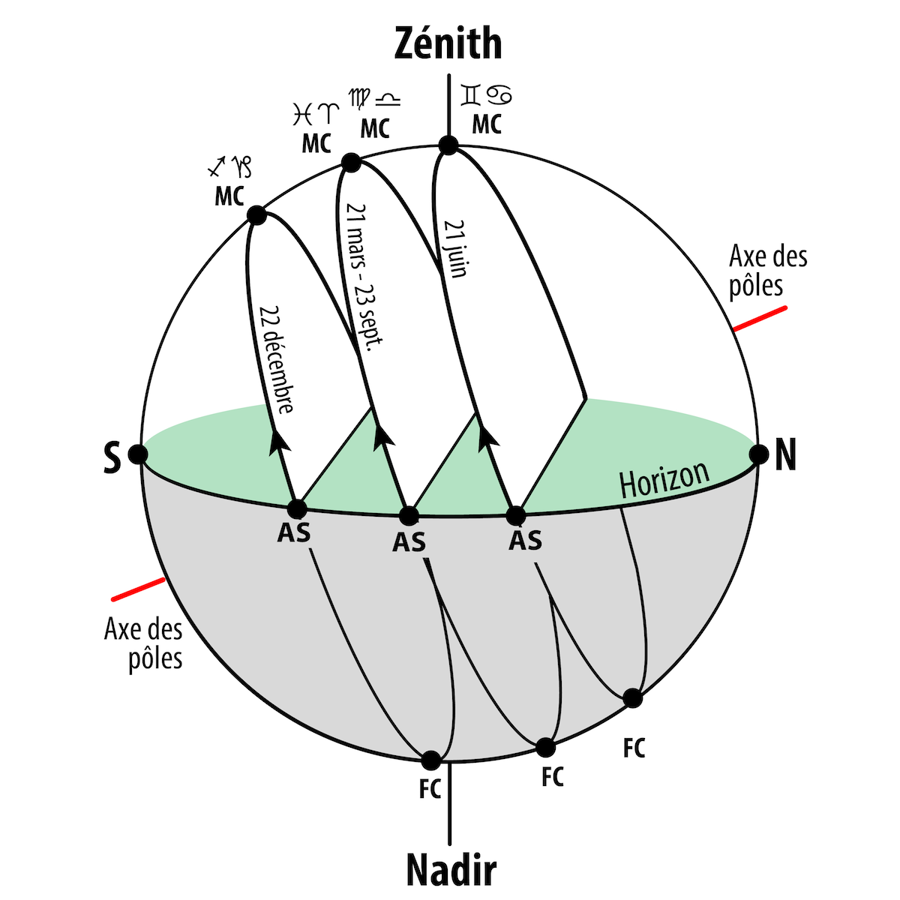 tropical zone
tropical zone
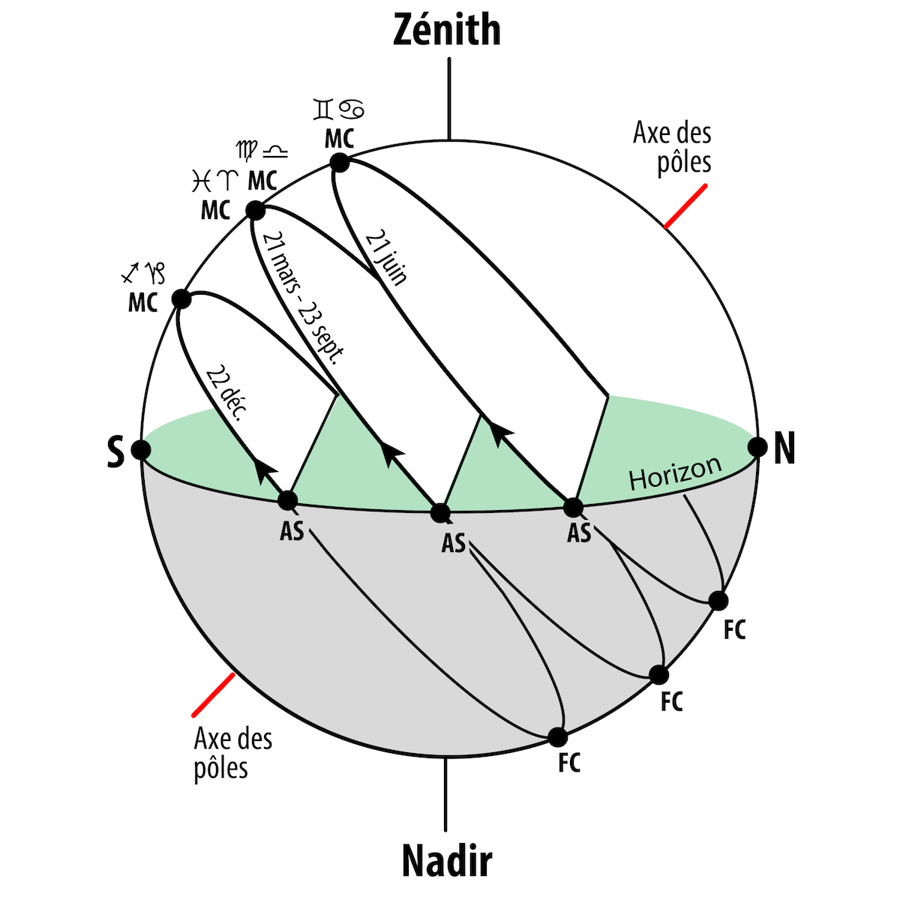 Temperate zone
Temperate zone
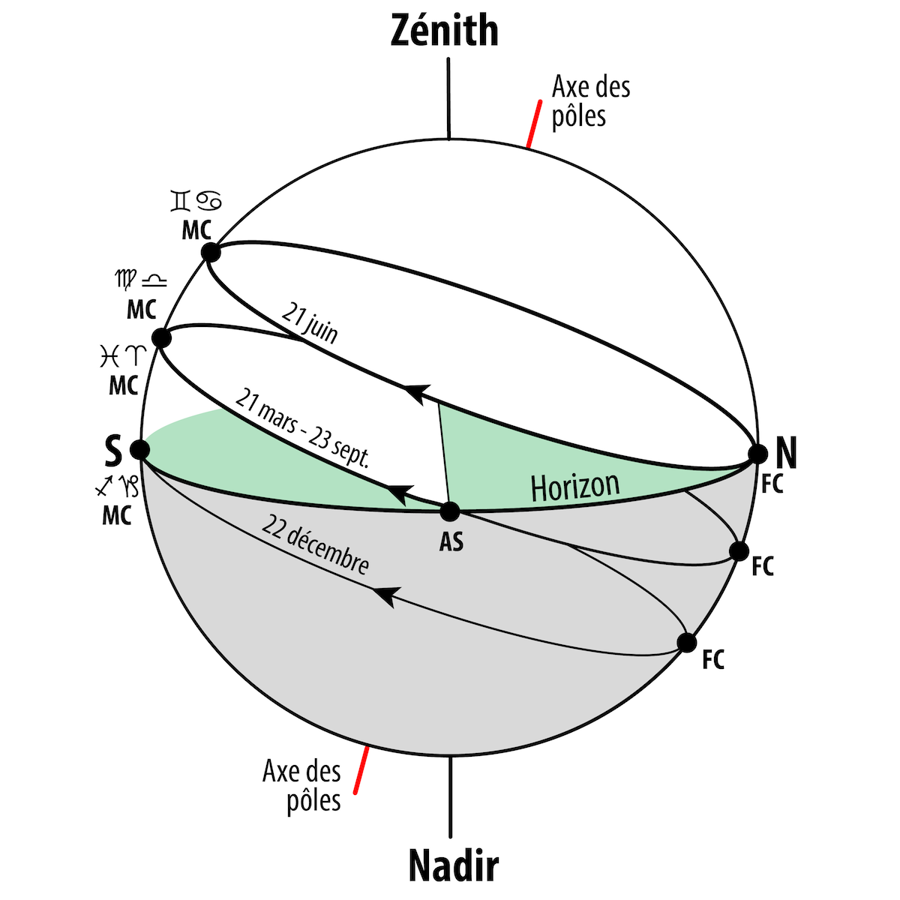 Glacial area
Glacial area
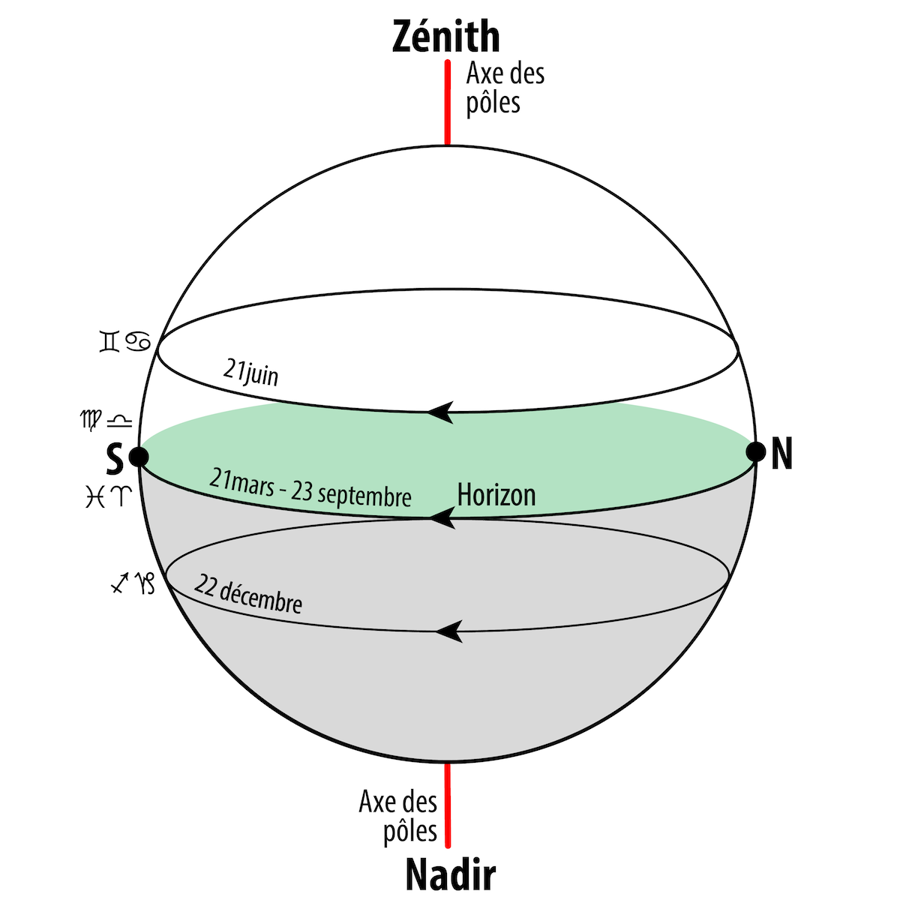 Polar area
Polar area
As far as the Sun is concerned, the declinations therefore act directly on the photoperiod, that is to say on the cyclical variations of day (photo = light) and night (darkness). The astronomical definition of day is the time the Sun is above the horizon or diurnal arc. That of the night is the time of presence of the Sun below the horizon or night arc. The planets therefore also have their photoperiod: their time of presence (diurnal arc) or absence (night arc) above the plane of the horizon increases or decreases according to declinations and geographic latitudes.
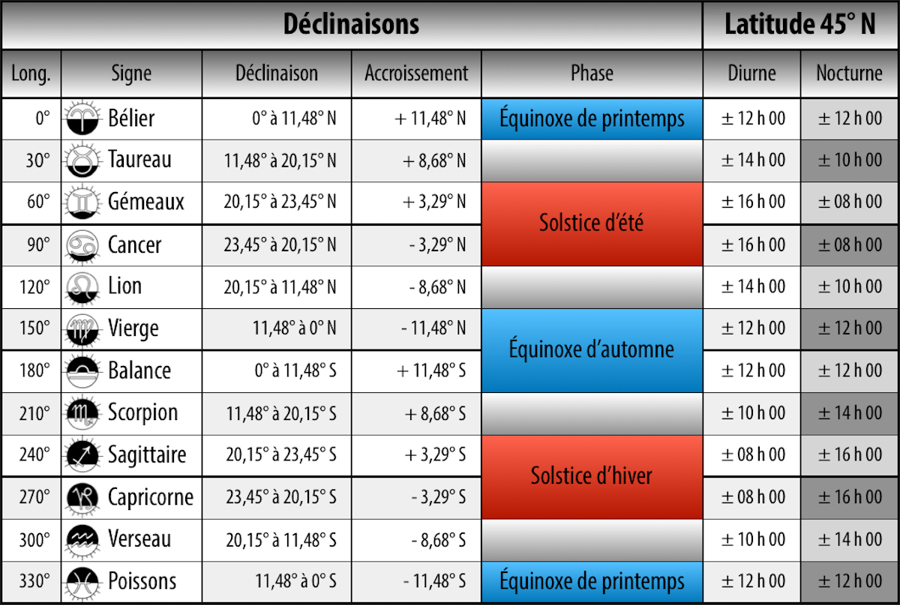
Independently of the case of the Sun, each Sign of the zodiac can therefore be defined by the ratio of its diurnal and nocturnal arc durations: the zodiac is therefore not of solar essence, and the solar photoperiod is only a particular case. The zodiac is specific to the Earth, it is the inclination of the Earth on its orbit.
The ratio of diurnal-nocturnal durations varies according to declination, but also to terrestrial latitude. In the equatorial zone there is an almost permanent equality of days and nights. In the temperate zone, the difference between daytime and nighttime durations is average. In the polar zones, it is extreme (six months of day, six months of night). As an example, the table above gives you the durations of day and night for the latitude of Paris.
The three images below illustrate the diurnal (in white) and night (in black) durations specific to each Sign of the Zodiac according to the terrestrial latitudes North equatorial (0°), temperate (45°) and circumpolar (75°). Note that the contrast between daytime and nighttime durations has been significantly exaggerated for the temperate zone, to a demonstrative end. The ratio of diurnal-nocturnal durations always remains substantially identical for the equinoctial signs (Aries, Virgo, Libra, Pisces). On the other hand, it varies considerably for the Solstitial Signs (Gemini, Cancer, Sagittarius, Capricorn). The effects of the photoperiodic zodiac therefore vary significantly according to terrestrial latitudes.
It is a banality to say that the alternation of diurnal and nocturnal rhythms our lives in depth, and yet it is the most direct and concrete manifestation of the reality of the photoperiodic zodiac.
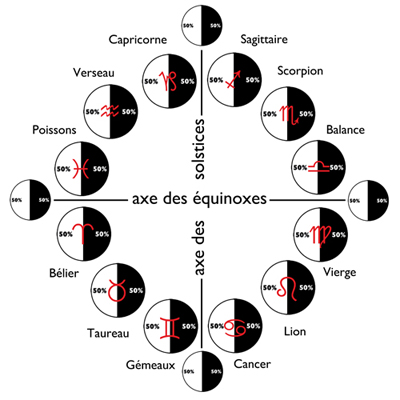
Ecuador: the figure above represents the photoperiodic zodiac for the latitude of Makoua, a city in the Republic of Congo which has the particularity of being crossed by the equator (0° 00′ 00″ latitude, 15° 38′ 00″ east longitude). The nychthemeron (from the Greek nukthemeron, word composed from nuktos, “night”, and hemera, “day”) of each Sign is expressed in percentages. Under this latitude exactly halfway between the two poles, the diurnal-nocturnal alternation is absolutely monotonous: 50% day (white hemispheres) and 50% night (black hemispheres): throughout the he year, the Sun rises and sets at almost the same time and the days and nights are of equal length.
Only the Moon and the planets, due to the inclination of their respective orbits on the ecliptic, can escape this monotonous alternation, when they have a ecliptic latitude important (this is the case of Moon, Mercury, Venus, Mars and Pluto). They then cover their diurnal arcs (above the horizon) and nocturnal arcs (below the horizon) in times greater than those of the Sun.
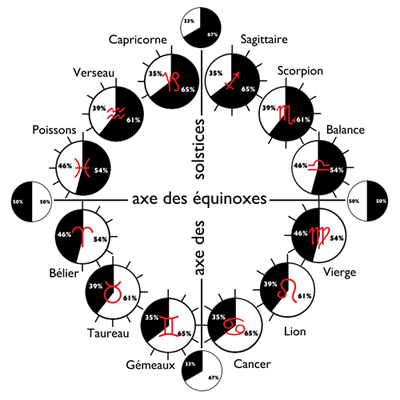
Equator-pole equidistance: the figure above represents this time the photoperiodic zodiac for the latitude of Dijon, a city in France whose geographic coordinates are 47° 19′ 18″ North latitude and 5° 02′ 29″ East longitude. Why did you choose Dijon which is 2° 19′ 18″ above 45th parallel, rather than the Croatian town of Senj which is exactly equidistant between the equator and the North Pole? Quite simply because it is a question here of the local photoperiodic zodiacs, that it is in Dijon that this text is written, and that 2° more or less does not significantly vary the ratio of day-night durations.
For this latitude, the diurnal and nocturnal percentages vary very clearly. The small circles represent the lengths of days and nights at the exact time of the equinoxes (50%–50%) and solstices (33%–67%). The percentages are calculated for 15° of each Sign (45%–54% for the Aries, Virgo, Libra and Pisces equinoctials, 35%–65% for the Gemini, Cancer, Sagittarius and Capricorn solstitials, and 39%–61% for Taurus, Leo, Scorpio and Aquarius intermediates).
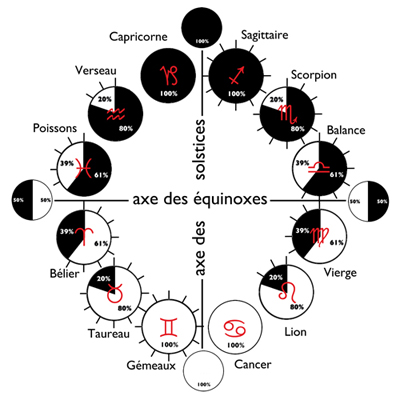
Arctic Circle: the figure above represents the photoperiodic zodiac for the latitude of Murmansk, a city in Russia whose geographical coordinates are 68° 58′ North latitude and 33° 05′ East longitude, and which is therefore slightly above the circle arctic polar located at 66° 33′ 45″ north latitude. Beyond the Arctic Circle (and therefore notably in Murmansk), the phenomenon of polar day, also called Midnight Sun. It’s according to Wikipedia “a time of year when the Sun does not set. This phenomenon occurs around the summer solstice (June in the northern hemisphere, December in the southern hemisphere) at high latitudes located beyond the Arctic and Antarctic polar circles. The number of days with 24 hours of daylight during which this phenomenon occurs increases with latitude. It reaches its minimum (one day) at the level of the polar circle, at 66° 34′ and its maximum (six months) at the pole (90°) and takes place in summer (March to September in the northern hemisphere, September to March in the southern hemisphere). Thus, on the day of the solstice, at the poles, the Sun remains constantly visible at a height of just over 23° in the sky.”
The period of sensible equality of days and nights is extremely short in these extreme northern latitudes. As for the previous figure, the small circles represent the lengths of days and nights at the exact moment of the equinoxes (50%–50%) and the solstices (100% day to summer, 100% to the winter one). Percentages are always calculated for 15° of each Sign (39%–61% for Aries, Virgo, Libra and Pisces equinoctials, 100% day or night for Gemini, Cancer, Sagittarius and Capricorn solstitials, and 20%–80% for Taurus, Leo, Scorpio and Aquarius intermediates). Note in passing and for example that the Sun, the Moon or a planet without ecliptic latitude at 15° Aries at 68° 58′ N has the same day-night percentage (61%–39%) as the Sun, the Moon or a planet with no ecliptic latitude at 15° Taurus at 47° 19′ N. Which means, from the point of view of the photoperiodic zodiac, that an individual born under a strong influence of planets in the 2th decan Aries in Murmansk would have behavioral characteristics identical to those of an individual born under a strong influence of planets in the 2th Taurus decan in Dijon. Simplifying to the extreme, this amounts to saying that an “Aries” of the 2th decan of Murmansk is like a “Taurus” of the 2th decan of Dijon.
Individuals born at more than 66° North latitude therefore only have Aries, Virgo, Libra and Pisces characteristics identical to those of individuals born at 45° North latitude only if they were born a fortnight before or after the axis of the equinoxes. Outside these temporal limits, they have Taurus, Leo, Scorpio and Aquarius type photoperiodic characteristics according to the zodiacal standards which reign equidistant from the equator and the North Pole. As for the case of the Arctic Solstitial Signs, it is even more extreme: the percentages of day and night for Gemini, Cancer, Sagittarius and Capricorn identical to those characteristic of 45° North latitude are reached from the 2th decan of Taurus, Leo, Scorpio and Aquarius in the zodiac of the declinations. There are therefore only extremely small time intervals for arctic “Taurus”, “Leo”, “Scorpio” and “Aquarius” to resemble those at 45° North latitude. On the other hand, by imagining a periodicity of births uniformly distributed throughout the year, the Arctic populations are marked by a very large class of “super-Gemini”, “super-Cancer”, “super-Sagittarius” and “super-Capricorn” born during the very long days and very long nights bordering the solstices of the Far North.

To illustrate this problem in a colorful way, let’s take the example of Capricorn. The figure above represents the percentages of day and night at 15° Capricorn for a birth at a latitude North of 0° (left), 47° (center) and 68° (right). A “Capricorn” (i.e. an individual born when the declination of the Sun was between −23.45° and −20.16° South) living in the equatorial zone will integrate the effects of a photoperiod identical to those Aries, Virgo, Libra or Pisces… An interference that seems complex to deal with… and a question to ask: is it really a “TRUE” Capricorn like that of an average terrestrial latitude of 47°? The same, if it was born in the polar zone, will on the other hand behave like a “super-Capricorn” (total night, absent day) and will therefore have absolutely nothing to do, from the photoperiodic point of view, with its tropical counterpart.
This issue of the interactions between declinations and photoperiod shows you that by basing the zodiac on astronomical reality, we inherit the complexity and the questions that are inherent to it, very far from the traditional and simplistic vision of a symbolic zodiac made up of twelve Fire, Earth, Air and Water signs with borders made perfectly watertight by the properties of the mythical Elements which define them.

The universal zodiac, that of declinations whose effects are independent of terrestrial latitudes, is thus declined in a multitude of local zodiacs, photoperiodic, each terrestrial latitude having a ratio of day-night durations which is specific to it… We can certainly reduce this multitude to a reduced number of categories: for example from 0° to 23.45° North or South (limits of the tropical zone), from 23.45° to 47° (zone between the tropics and the middle of the temperate zone), from 47° to 66° 33′ (zone between the middle of the temperate zone and the beginning of the polar zone). With four zones per hemisphere, we obtain a total of eight “photoperiod zones”, each characterized by a specific ratio of day-night durations for the twelve Signs of the zodiac. But these “photoperiod zones” would only be valid for the Sun which by definition is always exactly on the ecliptic: the Moon and the planets being frequently above or below this plane, it would always be necessary to calculate precisely their real positions with respect to the local horizon, which depend on the precise latitude of the location for which the sky chart is mounted.
This fact brings to mind an essential point: the photoperiodic zodiac is not solar. For the Sun and for it alone, the diurnal arc (time of presence above the horizon) corresponds to the day and the night arc (time of presence above the horizon) corresponds to the night. The Moon and the planets can thus traverse their nocturnal arc while the Sun is on its diurnal arc (so it is daytime) and vice versa. We can thus consider that day and night are only specific modalities, specific to the Sun, of the phenomenon of the division of the movement of the stars in the local sphere into diurnal and nocturnal arcs.
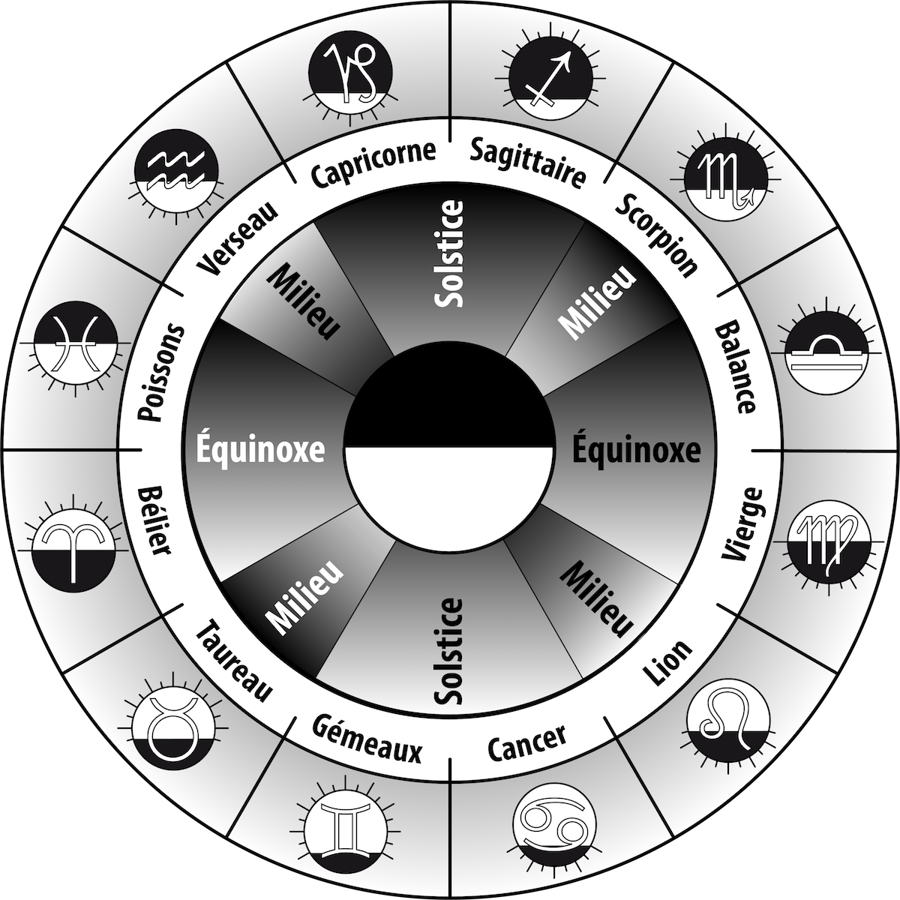
Moreover, this division into eight photoperiod zones would only prolong the myth of a zodiac made up of twelve Signs with perfectly sealed borders. Indeed, apart from specific points such as the equinoxes and the solstices which mark the change in duration of the dominant arc (equinoxes) or the transition from growth to decrease (or vice versa) of this arc (solstices) of the Sun, Moon and Planets and thus define clear and astronomically indisputable limits for the Signs concerned, the borders of the intermediate Signs (Taurus, Leo, Scorpio, Aquarius) are as arbitrary as those of the “photoperiod zones”.
If the zodiac was finally divided into twelve sections called Signs (after having only had eight!), it was to account for the specific effects of the zodiacal zones located near the equinoxes (Pisces-Aries, Virgo-Libra) and solstices (Gemini-Cancer, Sagittarius-Capricorn) and those that were in an intermediate section (Taurus, Leo, Scorpio and Aquarius). When the Sun, the Moon or a Planet passes from Pisces to Aries, for example, there is a decisive change in its state: its diurnal arc, which was not dominant in duration in Pisces, becomes dominant in Aries. This decisive astronomical criterion suffices to clearly differentiate these two sections of the zodiacal cycle.
It is not the same, for example, for a Planet at 30° of Aries or at 0° of Taurus: nothing changes in its state when it passes from one Sign to the next. The diurnal arc remains increasing and dominant in duration, and the diurnal-nocturnal relationship continues under this regime throughout the quarter of the zodiac between the spring equinox and the summer solstice. The division of the zodiac into twelve Signs of a uniform extent of 30° each therefore appears arbitrary, even if it is attractive for the spirit of geometry, which spontaneously tends to divide a circle or a cycle into two, four or twelve. sections or periods. The boundaries of intermediate Signs are therefore blurred. It is impossible to decide, from indisputable astronomical criteria, when the transition from Aries to Taurus and from Taurus to Gemini takes place.
Could there be two kinds of zodiac: the zodiac of declinations, universal, invariant whatever the terrestrial latitude, and the photoperiodic zodiac, local, varying according to terrestrial latitudes? The answer to this question is negative: there is only one zodiac, at the same time universal by the specific variations which characterize each of its Signs, which zodiac is… available in different photoperiodic versions depending on the latitudes. One of the major problems that arises in astrology is that of the articulation between the universal zodiac of declinations and its local photoperiodic effects, and the real question that arises as follows: what is the dominant and determining influence? The universal one of declinations or the local one of photoperiods?
A little detour through tropical botany will perhaps help us answer this question. Francis Halle cannot be suspected of astrologism. Director of the tropical botany laboratory at the University of Montpellier II, his scientific specialties — tropical botany and the architectural analysis of trees — led him to visit all the forests surrounding the equator, to study them, and therefore, necessarily to note that they were in the process of disappearing because of the overexploitation of the woods and uncontrolled agricultural clearings.
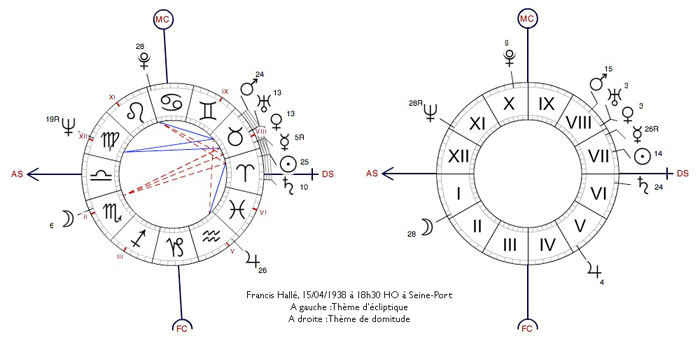
It was therefore as a botanist that this biodiversity activist, born on April 15, 1938 in Seine-Port, was led to take an interest in photosynthesis and photoperiodism. His curiosity led him to wonder about the effects of photoperiodism on the human species. Here is what he said to Vincent Tardieu in an article devoted to his research in everyday life Release from 05/09/1990: “Take a world map and look at the intertropical region. Overlay it on a world map of GNPs. You will be able to see that the developed areas are located outside this band, at the level of the mid-latitudes.”

Of course, there is the case of developed or relatively developed countries straddling the tropical border. Hallé does not hesitate to approach it, noting that: “either their capitals are built outside the tropical strip, or when they are located inside—often on the edge of the tropics—the country’s economic driving centers remain extra-tropical.”
Admittedly, there are flourishing economic zones within or around the equatorial-tropical space: Singapore for example, but: “Like Hong Kong, this world economic center was built by Chinese people who came from mid-latitudes, particularly motivated […] what would apply to economic underdevelopment would also be found in the non-existence of proper research, absence of revolutions (Cuba and Managua then remain enigmas), the weakness of the notion of State, etc.”
Nothing really new under… the sun, apparently. Francis Hallé, however, puts forward an explanatory hypothesis which seems to confirm the preeminent effects of the photoperiodic zodiacs in relation to the declinations. Without neglecting the historical, geographical and economic aspects of tropical underdevelopment, Hallé argues that one of its major causes could lie in the astronomical situation of this area: “While at our latitudes the variations in the length of day and night are strong, with during the solstices an alternation of eight hours of day and sixteen hours of night, then conversely, under the equator, this duration is invariable throughout the year, equal to twelve hours. As for the tropics themselves, the amplitude hardly exceeds more than 200 minutes.”
He concludes that: “Human beings, everywhere biologically the same, with the same drives and the same essential faculties, could not synchronize their faculties correctly in the tropics because of this stability of the photoperiod… In this kingdom of monotony it would be the reign individual free rein, a no man’s land where energies would find it difficult to federate, where consensus, critical mass would be too rarely achieved to work for development.”
How not to recognize in this “realm of monotony” the effects of permanent or quasi-permanent “egalitarian phase” (day-night equality concerning, let us remember, the equinoctial signs) experienced by the inhabitants of the equatorial and inter-tropical zones, and in this difficulty to achieve “consensus, critical mass”, lack or weakness of “Meaning of dosages” weight (Intermediate signs) and the “Sense of Sets” federator (Solstitial signs)…
Hallé’s observations therefore seem to point in the direction of a very strong influence of photoperiodicity, and therefore of local zodiacs, specific to each terrestrial latitude, on the behavior of the human species. In this hypothesis, the universal declination zodiac would in some way only be the producer of its local photoperiodic variants, which observation and experience seem to confirm by studying the effects of reflexological zodiac, internal to Man : it is indeed to photoperiodic variations that the human nervous system reacts.
The photoperiodic zodiac poses another problem. When day lengths increase in the northern hemisphere, they decrease in the south, and vice versa. Since each Sign of the zodiac draws its meaning from its diurnal-nocturnal relationship, logic would require us to reverse the Signs in the Southern hemisphere: an Aries in the North (dominant and increasing diurnal arc) would then be a Libra in the South (arc dominant and increasing nocturnal).
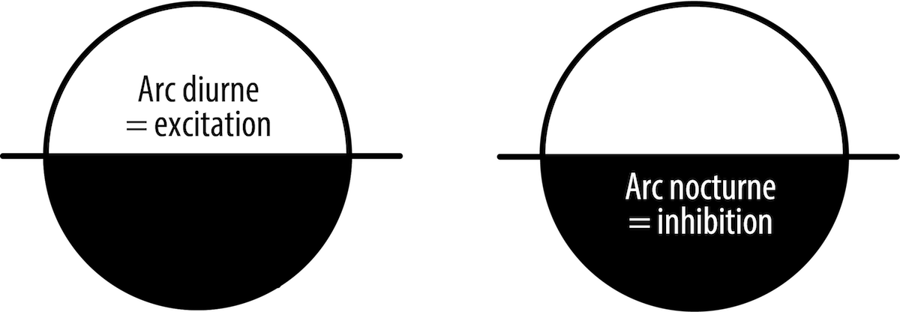
It is not obvious and, to tell the truth, experimentally, we do not know anything about it. What we are sure of, and the statistical work of Michel Gauquelin have confirmed, is that in the northern hemisphere (where almost all of the approximately 29,000 births concerned by this work originated), the planetary effect is more evident above the horizon (diurnal arc).
The diurnal arc would thus have an effect “exciter”, while that of night would be “inhibitor”. Is it the same in the southern hemisphere? It seems very likely. But to be sure, the same kind of massive statistical study would have to be done in the southern hemisphere. This phenomenon leads us to pose three and perhaps four hypotheses.
First hypothesis: if this is indeed the case, there would be an inversion of the Signs in this hemisphere. It would then be necessary to give absolute precedence to the local photoperiodic zodiacs, specific to each North or South latitude, which will not fail to raise new problems, and to consider the declinations only as the matrix which determines the characteristics of these zodiacs.
Second hypothesis: that of the interference of the effects of declinations (universal zodiac, independent of terrestrial latitudes) and photoperiod (local zodiacs, specific to terrestrial latitudes), according to a dosage that favors the universal over the particular. In this view, a Capricorn remains a Capricorn regardless of the latitude at which he was born, but there would be various types of Capricorn, which can be reduced to a minimum of four: the equatorial Capricorn, the tropical, the temperate and the polar ones… And the same obviously goes for all the other Signs. In this hypothesis, it is not impossible that the declination-photoperiod superposition increases the zodiaco-planetary effects in the North and decreases them in the South. Astrology was born and developed in the temperate zones of the northern hemisphere, and there is no trace of an astrology worthy of the name in the southern hemisphere, despite the great civilizations that have settled there. deployed. One can wonder if this is not due to the fact that the zodiaco-planetary effects are more evident in the North than in the South…
The figure above represents the terrestrial areas affected by the universal diurnal and nocturnal rhythms for 0° of each sign of the zodiac: we see that the declinations act directly on the illuminated or unlit surfaces of each hemisphere, whatever the terrestrial latitudes. This phenomenon could possibly plead for a universal zodiac.
Third hypothesis: this is a strong variation from the previous assumption. In this version, one can imagine that the human species as a whole has adapted to the declinations and photoperiodic zodiacal variations they induce by synchronizing with a diurnal-nocturnal “average”, corresponding consequently to the characteristic photoperiods of the terrestrial latitude of ± 45° North or South equidistant from the poles and the equator. This hypothesis leads to two possibilities: either the effects of this “averaged” photoperiodic synchronization marginalize or extinguish those of the local photoperiodic zones—and in this case, there would exist a universal average photoperiodic zodiac, or the effects of the local photoperiodic zones more or less modulate strongly those of this hypothetical universal average photoperiodic zodiac, which seems to confirm the observations of Francis Hallé.
To know which of these hypotheses will be validated or invalidated, it will be necessary to accumulate statistics and experiments with the subtropical and circumpolar populations of the two hemispheres. Let us recall in passing that almost all of the approximately 29,000 births on the basis of the Gauquelin statistics have made it possible to confirm the character “exciter” of the diurnal arc and “inhibitor” of the nocturnal arc in the northern hemisphere, this cohort was also composed almost entirely of births located in Europe and the U.S.A. for a reason that has nothing to do with declinations and photoperiods. These are indeed the only regions of the world with civil status services effective in collecting relatively reliable birth times, essential for this type of study.
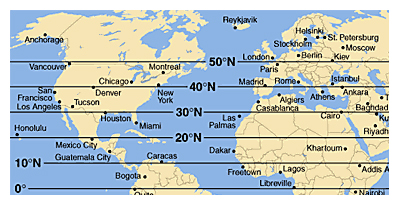
However, Europe and the U.S.A. extend between about 30° and 55° North latitude (which is precisely the area where the zodiac was discovered and conceptualized): Gauquelin’s statistics therefore only concern this area.
It remains to proceed with the zodiacal exploration of the others… which hardly interests anyone and especially not official science. It will therefore be necessary again and for a long time, for lack of means and explorers to implement them, to remain in ignorance on this subject.
Finally, as J.-P. Nicola notes, “in the question of the inversion of the Signs, if we adopt a center of symmetry (the center of the Earth) rather than an axis (the equatorial plane), it seems obvious that the geographical coordinates of a given place (40° North — 20° West, for example) can only be reversed by the coordinates of the diametrically opposite place (40° South — 20° East). Now, with respect to the plane, and not with respect to the center, another possible symmetry keeps the same longitude. This symmetry changes the problem of the inversion of the Signs”… another hypothesis, and a problem that remains open to astrology based on reality, and still undecided.

A zodiac sign has no reality in itself. It is never more than a geocentric (declination) or topocentric (photo-period) frequency of a planet. Take the example of “Mercury in Aries”, and describe this phenomenon:
▶ 1) The planet Mercury, whose sidereal duration is 88 days (heliocentric frame of reference)…
▶ 2) … has a declination between 0° and +11,48° North (geocentric reference frame)…
▶ 3) … and, if it has no ecliptic latitude and at the latitude of Paris, its diurnal arc is between 12 h 00 and 13 h 48 (topocentric reference frame).
What makes the difference between Mercury in Aries and Mercury in another Sign is therefore the inclination of the Earth in its orbit and the terrestrial place of observation. Without Earth, no zodiac. If we take Mercury out of this description, what is left? The declination and diurnal arc of a nonexistent object. A sign without a planet is an astronomical abstraction.

It is so true that at the extreme limit, one can interpret the planetary structures of a chart by neglecting the zodiac: Mercury remains Mercury, whatever the Sign it occupies. There is little risk of being mistaken in analyzing, in oneself, without taking into account the Sign occupied by Mercury, a dominant Mercurian function. The reverse is not true: one cannot correctly interpret a chart based exclusively on the Signs and neglecting the planets.

Nowhere in this presentation of the astronomical foundations of the zodiac, based on the inclination of the Earth in its orbit and on the declinations and diurnal-nocturnal variations which it implies, has there been any mention of the constellations which lie at the background of the Signs and the Planets. This for a good reason: the zodiac of the constellations only interests ignorant anti-astrologers who confuse or pretend to confuse the characters of a tragicomedy (the Signs and the Planets) with the setting in which they evolve (constellations).

A article of this site explains in a detailed way the phenomenon of the precession of the equinoxes, which is at the origin of the discrepancy between the Signs of the zodiac and the constellations which bear the same name. We will therefore not return to it here. I only suggest that you look at the figure opposite to understand what it is. The central circle represents the astronomico-astrological zodiac as it has been described in this article. In the circle that surrounds it are the constellations, groups of stars (arbitrarily linked by straight line segments) close to the plane of the ecliptic: they constitute the background, the decoration on the background of which the piece takes place. of zodiac-planetary theatre. To please the ignorant anti-astrologers, I placed Ophichus, a constellation corresponding to no sign of the zodiac but nevertheless located near the ecliptic. Finally, outside this circle are figurative zodiacal image-symbols corresponding to the constellations. You will find that it takes a lot of imagination to match the designs of the former with those of the latter.
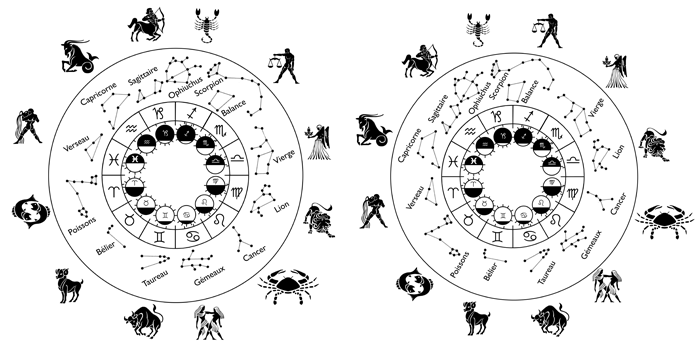
This figure represents the state of the sky about 4300 years ago, at a time when astronomers-astrologers could not know that the vernal point or 0° Aries made a complete turn in about 25,776 years, or 30° d ecliptic every 2160 years.
To locate themselves in the sky, they therefore gave the same name to the zodiacal phenomena specific to the Earth and to the constellations that were in the background.
The two figures above show you, for the one on the left, the state of the sky about 2160 years ago:
▶ it is then the constellation of Pisces which was in the background of the Sign of Aries;
▶ and for the one on the right the state of the zodiac-constellation relationships for the next 2160 years (we are inside), with the constellation of Aquarius in the background of the Sign of Aries. As for the diagram opposite, it illustrates the astronomical mechanism at the origin of the precession of the equinoxes.
This discrepancy between Signs and constellations gave birth to a great myth: that of the “astrological eras” (era of Aries, Pisces, Aquarius, etc.).
As you can see, this is only a change of stellar scenery: the terrestrial zodiac in the center of the two diagrams has not changed. You really have to be in bad faith and/or unfathomably stupid, like the anti-astrologers where the sidereal astrologers for failing to understand this simple reality.
▶ Your zodiac Sign
▶ Signs and seasons
▶ Planetary trios in Signs
▶ The zodiac and the precession of the equinoxes
▶ Zodiaque des Signes & constellations : vidéos
▶ The astronomical reality of the zodiac
▶ The human reflexology zodiac
▶ Autour du zodiaque : de l’eau dans un Signe de Feu ?
▶ Zodiaque et sphère locale
▶ Mythologie du zodiaque
▶ Zodiaque et formes de l’inhibition
▶ Change-t-on de caractère en changeant de Signe solaire ?
▶ Énergie-Espace-Temps-Structure et zodiaque
▶ Genèse du zodiaque conditionaliste
▶ L’horloge photopériodique du genou
▶ Signe solaire et Signe Ascendant
▶ Astrologie, adaptation & inadaptation
▶ Les rythmes du zodiaque
▶ Cosmographie simplifiée du système solaire
▶ Thème de domitude et hiérarchisation planétaire
▶ Effets et contre-effets des images et représentations sur les faits et les idées
▶ Le taijitu dans le système solaire
▶ Zodiaque, planètes et typologie jungienne
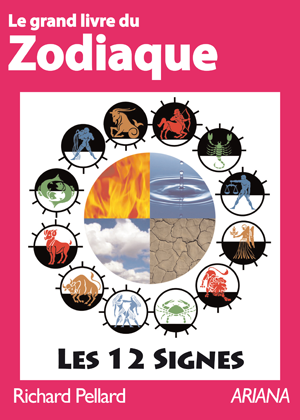
Le grand livre du zodiaque
par
180 pages. Illustrations en couleur.
Ce livre présente et explique les trois zodiaques : celui du décor des constellations, celui de l’astrologie traditionnelle basé sur les Quatre Éléments symboliques (Feu, Terre, Air & Eau) et celui de l’astrologie naturelle basé sur les phénomènes astronomiques objectifs.
Téléchargez-le dès maintenant dans notre boutique